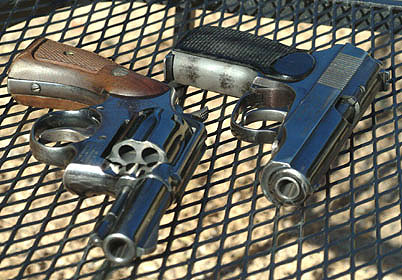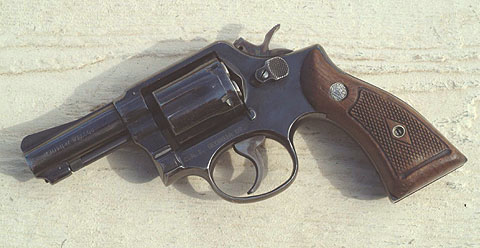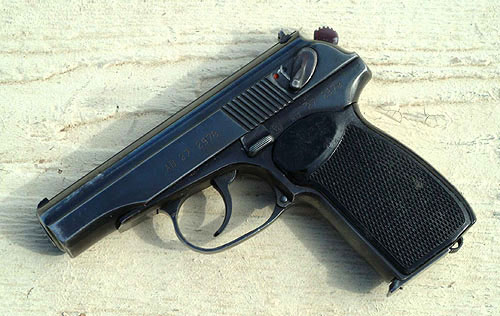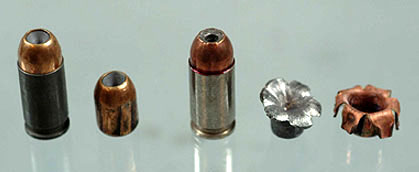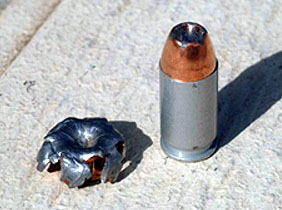or call me most any day after 10 am central time at 281 565 6977.
*********************************************************
Making the J-Frame .38 Snub Work
By Stephen Camp
Out of vogue for many these days is the snub-nosed .38 Special revolver. Some still do tote one by choice as either their primary concealed carry handgun while others relegate it to backup duties for a more potent piece. Snubs can be had in several calibers and more than one frame size, but this article will focus on the J-frame Airweight .38 Special. I suggest that what is discussed here would apply equally to J-frames be they of steel, stainless, or one of the newer metal alloys used these days. I prefer to Airweight (aluminum frame) to all-steel as I tote the snub via pocket holster and find the latter a tad heavy for this convenient mode of concealed carry. The Airweight is plenty light but heavy enough that one does not usually have to worry that certain bullets will work out of their cases under recoil. This cannot be said for some of the newer revolvers that are even lighter than the Airweight. If I couldn't find an Airweight snub, I'd go for the heavier rather than the lighter versions.

Range time is essential if we expect to be able to use the snub .38 as more than just a threat. These are not the easiest handguns to shoot well. They do have quite a bit to offer for those willing to try.
Clint Smith is reputed to have said something to the effect, "Handguns are meant to be comforting, not comfortable". I tend to agree if one is pretty sure of treading a hazardous path, leads a high-risk life-style, or works in a dangerous profession. Before retiring as a full-time peace officer, I seldom carried less than a 9mm or .45 automatic off duty. Were I in the jewelry business in Los Angeles or a bodyguard or something similar, I would not rely solely on a snub. More than likely I've served my last arrest or search warrant. I'll not kick in any more doors or be sworn to confronting and arresting wanted felons known to be dangerous on sight. These days I'm around the house feeding ducks or goldfish, writing a bit, at the range, or hunting lease and that's about it. Before he passed, my father was in need of constant medical attention. On one hurried trip into a large city after the midnight phone call, the snub was in my pocket all right but there was a cocked-and-locked .45 in a strong side belt holster as well. The area around the hospital had been the scene of a recent homicide and several aggravated robberies. Going into a know risky area I wanted "comforting" more than "comfortable." You get the idea; for most of my time I'm in a very, very low risk environment. True warriors will opine that one could be under deadly attack at any time and that is true, but we all play the odds to a degree. Knowing that a dozen gang bangers were heading my way to rid the world of my shadow and that I couldn't retreat or get police intervention, I'd go with something other than a handgun to be sure. At the same time, I refuse to be "naked" and want a firearm on or near me 24/7. More than any compact 9mm or .380 ACP, the snub .38 meets my own personal requirements…at least to the minimal level. For me, the .38 snub excels as a pocket gun. If going to a belt gun, OWB or IWB, a more effective and larger handgun can easily be carried.

This S&W Model 42 is accompanied by extra ammunition carried via both the speedloader and the speed strip. The Fobus paddle holster is comfortable and carries the gun well for me, but if going to a belt gun, I suggest that we go with a more efficient handgun. To me, the snub shines as either a pocket gun or a backup.
At the same time, I absolutely reject carrying a weapon that cannot be used effectively. The compact snub can be (depending upon how one defines "effectively"), but it takes work. At my personal minimum for "power" and with limited shots on tap before reloading, it is essential that the snub user be able to make each and every hit a decisive one.
If you carry or plan to carry a snub, perhaps my practice recommendations might be of at least some use. Most of the time I go to the range and shoot some sort of handgun at least once per week. Frequently I might go two or three times depending upon my schedule or if a project is in the works. I make it a point to shoot my J-frame at least once every other week and often more. The snub is shot slow-fire for practice at precision work, rapid-fire for when that might be essential, and a bit of point shooting is included. I also suggest some strong and weak hand shooting in additional to the usual two-hand hold.

Practice ammunition is essential in getting good with the snub .38. It can be purchased or handloaded. Pictured are various handloaded cartridges I've used for range work with my snubs.
"But the snub ain't no target gun. It's a belly gun meant for up close and personal!" True enough until it's not. What if you're required to make a shot where you can only see part of your aggressor? What if you have to take a "rescue" (head) shot at 10 yards? What if you have two opponents and but two shots left…and they're rapidly advancing? You'd have to almighty quick to reload with a full five before they get to you in most instances, Jerry Miculek excluded.

These groups were fired with an Airweight at 10 yards in slow fire. This particular gun hits a bit to the right, but notice that at this distance, there's just not that much difference in POI between the 125 and 158-gr. bullets.
The old saying that "practice makes perfect" is not true. Perfect practice does…or at least lets us see improvement.
The very attributes that make the snub so easy to carry work against making it easy to shoot well. It compactness translates to short sight radius. Lightweight equals greater felt recoil and a harder gun to hold steady against the double-action trigger pull. The small cylinder means 5 shots instead of the usual 6. The 1 7/8" barrel results in lower velocity than longer barrel revolvers and we don't get full case extraction unless the ejector rod is depressed briskly.
Accurate shooting of the snub is possible despite the preceding downside issues. All shooters have the desire to be good shots. Fewer have the desire to do the work required to get there. I am certainly not a master shooter, but several approaches to marksmanship have helped me and translate well to the snub revolver.
Assuming that one already has understanding of shooting fundamentals like trigger control, breathing, grip, sight alignment, sight picture, and so forth, let's tailor a little shooting regimen for the snub .38.
Start at relatively close range: Even though we're speaking of accurate "target shooting" here, most are best served by starting off at 3 to 5 yards. Error magnifies itself with distance. Seeing groups come down in size builds confidence and that encourages practice. As repetitions of correct trigger pull, etc, burn themselves into the shooter's hardwiring distances can be increased. Don't get into too much of a hurry to do this and don't get in a rush for firing more quickly.
Don't shoot beyond your individual fatigue limit: 99% of shooting is done "between the ears." In other words, we have to use our brains. This requires concentration and concentration is the handmaiden to fatigue. The great marksman and Marine sniper, Carlos Hathcock, said that when "working" he would "crawl inside his bubble." He was saying that he was concentrating at the maximum level on his sight alignment, breathing, and so forth. It's exceptionally easy to fire the gun, but not so easy to make the bullets go where we want them. There is a price. It's concentration and mental fatigue. Just routinely burning ammunition is not good once we get beyond checking for reliability and familiarity with the snub. When tired I tend to let down my guard so to speak. I think we all do and this allows for bad traits such as jerking the trigger, etc. to crop up. It seems like these bad habits can be ingrained with but a few shots, but require many to break! Bad shooting technique is hard to "unlearn."
For many beginning shooters, 50 to 75 meaningful shots are about right for the serious range session with the snub. The number of rounds that can be fired using correct techniques will increase as the shooter's practice continues over the weeks, as will the distances at which hits can be made.
Use realistic targets: A 1" dot at 25 yards is not a realistic target for the snub. I suggest a bullseye roughly 4" in diameter for distances out to about 15 yards. I also use the same size target at ranges of but a few feet. Is this not roughly the size of a human heart? For most folks it has been my experience that this size target allows them to not cover the target completely with the front sight, obscuring it. There is also a place for humanoid targets with the snub, particularly when the shooter gets to more rapid firing or wants to practice "failure to stop" drills which involve chest and head shots combined.
Shoot regularly: If at all possible practice with the snub at least once a month at the minimum. It has been my experience that 10 really good shots fired each day accomplish more than 50 fired at one time at the end of the work week. Most of us do not have ranges at our homes and cannot get to a firing range each day so this is not attainable. That said, most reading this do shoot. Take the snub and a box or two of ammunition to the range with you and put forth the effort to have a short, but meaningful training session.

You can see that my Model 642 has been shot more than a little! Practice and regular range visits are necessary to get our best from the snub.
Shoot ammunition you can handle: Ammunition intended for defensive purposes is often a bit more powerful than standard loads not having expanding bullets. While it is necessary to shoot some of the ammunition we intend to carry in the gun, not each and every shot has to be. Who has heard the dictum, "Practice with what you carry"? It's my view that this is more applicable to ammunition for use in semiautomatics. Feeding and extraction reliability are more ammo dependant than with the revolver. This emphatically does not mean that revolvers cannot malfunction and it does not mean that some ammunition can contribute to this. Years ago a friend of mine was involved in a shootout. His .357 was loaded with ammo he'd never even fired. All six shots were required and he could not reload. The fired cases had expanded so much that they couldn't be extracted. Fortunately, the "problem" had been "solved" by that point, but we see that the reliable revolver is also ammunition dependent to at least some degree.
My practice loads are either handloaded or are the inexpensive FMJ sold by Federal, Winchester, or Remington. I use Remington 158-gr. LSWCHP +P for carry. Most of the time I practice with the inexpensive ammunition, but do fire a cylinder-full or two of the hotter loads when changing carried ammunition for fresh. Felt recoil is greater, but such will not be felt in a life or death defense scenario. It will have a slightly different point of impact than the usual practice rounds, but the difference is minute, particularly out to about 7 yards. At ten yards if the practice load hits near the middle of the suggested 4" target, the 158-gr. LSWCHP +P will, too.
Most of the inexpensive FMJ ammunition used for the range weighs 130 grains. If you're really concerned with slight variations between points of impact with the heavier +P load, there are standard velocity JHP's in the 110 to 125-gr. range. I prefer the heavier 158-gr. LSWCHP +P.
At least once per month, fire a few rounds of your "carry ammo."
Practice reloading: Five shots are not many. For most of us private citizens, they are enough, but that cannot be a hard and fast rule. Be sure that you can fully eject fired cases from your snub with one hand. I carry and use the HKS speedloader and carry at least one in addition to my snub. I find that these are easy to carry concealed and are quicker for me than Bianchi speed strips. The strips are flatter and can be used when more than one reload is being carried. Whichever you prefer, practice with them.

Whether you use speed strips like this one or a speed loader, practice using it. Conveniently carried extra ammunition is meaningless if it cannot be accessed and used in very short time frames.

If loading singly, be sure you control the revolver. Note how the shooter's left hand supports the gun and rotates the cylinder. This allows for relatively rapid reloading, particularly if you practice loading two at a time.
Make sure that your snub "fits" you: Usually this primarily refers to having a set of grips that are comfortable. Unlike belt guns to a degree or target pistols, there are limitations on grips for the snub. Sometimes we have to balance concealability against comfort. The small stocks common to J-frames decades ago were certainly easy to conceal but they allowed the gun to really twist during recoil. Most of us added Tyler grip adapters to fill in the space along the front grip strap and under the rear of the trigger guard. This helped immensely and I have no problem with that set up today. More comfortable grips could be had from several makers but they were just too large. I see little point in putting grips nearly as large as those for K-frames on the J-frame snub if the pistol is to be carried concealed. I offer this general rule of thumb for picking J-frame concealment grips: no longer than the bottom of the grip frame and no covered back strap. Each increases the size of the butt with regard to concealment. They may very well be more comfortable to shoot, but they will be harder to hide.

A number of grips exist for the J-frame. I prefer the boot grips on the gun to the others shown. They offer concealability as well as better control than the original S&W grip like the smooth one shown at the bottom middle of the picture.
So far the "best" carry grip I've tried for pocket carry has been the checkered rubber copies of Craig Spegel's popular boot grip. These come standard on S&W J-frame snubs. I find the J-frame snub significantly easier to control with these than with the old grip from years ago. I actually prefer the rubber to wood in this instance. The reason is that pocket carry in hot climates lends itself to sweat coming in contact with grips day in and day out. Eventually this will stain the wood grip next to the body and it can sure lead to a rusty grip screw. I cannot abide rust. I wipe off my carry snub each day and also put a bit of oil on the grip screw. This will not be absorbed by the rubber grip, but can be with wood. Whether you opt for wood or synthetic, I strongly recommend the boot grip style stocks for the snub.
Forget ego and shoot beyond your comfort zone: Those damned bullseye targets are unforgiving things! They show each and every mistake and resulting poor shot. Once we have gotten to where we can keep our shots in a nice tight group, we tend to keep repeating it. We tend to "like" that which we do well at. The problem is that if this is at but 10 feet, we're pretty limited in our ability with the snub.
Move the distance out a little. If you've been practicing at 5 yards and can keep your shots in the bullseye, begin shooting some at 7 yards. Continue this until you're seeing that, by golly, you actually can shoot tight groups farther out. If you can work your skill level up to the point that you can practice confidently at 10-yards or so, the snub .38 will probably serve well in a deadly force encounter. When at this level, practice some at greater distances and keep doing the work closer in, too. I think ten yards is a reasonable training distance for folks used to the snub and one worth working toward for those who are not.
Each of us has our own cadence when shooting. It's one we're sure of getting the hits with; it's comfortable. Too often, it's slow. Earlier I railed against shooting too fast, but once accuracy levels have been met, we need to build our speed a bit. At the same time we do not want accuracy to go out the window.

This group was fired at 7 yards, rapid-fire. Actually it is approximately twenty 5-shot rapid-fire groups fired in a practice session with the J-frame. Toward the end, I bumped up my cadence a little and you can see the shots that are a bit farther out of the primary group. With time and practice, perhaps I can shrink the group a bit.
If you're shooting well at 10 yards, move in to about seven. Now, shoot a bit faster than you normally do, but do not forget about sight picture and trigger control. Your first few attempts will probably result in slightly larger groups. Try it another time or two and see if you're holding your own. If you are, just keep working at that pace and see if the groups don't drop on back down with time. If they do not, slow down a little. It may be that smaller increments of speed are in order.

Reactive targets such as this falling plate (one of six in a row) can be lots of fun and a break in the usual paper targets. Shooting multiple targets that react is good practice and there's also something to be learned and guarded against! These plates are larger than the recommended 4" bullseye targets mentioned earlier. Yet many who can regularly keep all their shots in the bullseye will miss the plate. Guard against letting your focus move from the front sight to the target. It is easy to do. Stay on the sights and you'll get the hits.
Don't just assume that you can do no better. Push yourself a little; you might be very pleasantly surprised, but don't go beyond your fatigue point. (As you become a more seasoned shooter with the snub, I bet you find that this point comes later and later.) If you can, shoot with folks who are better than you are. Much of the time this tends to make us bring our levels up to more closely match those more skilled.
Shoot in various ways: Most of our shooting is done two-handed. I strongly suggest that we practice some one-handed shooting, too. Do this with both strong and weak hand. It will not initially help our egos, but it might just save our lives if we work at it. (You will appreciate those boot grips here!)

My primary carry snub is the double-action-only Model 642. Shown is a Model 638 fitted with the small S&W grips. Note that this revolver's capable of being cocked for single-action firing. I would practice some single-action shooting with it but strongly suggest that the majority of your shooting be double-action.
I am a proponent of using the sights whenever possible. What if it's not possible? What if we have to fire at very close range and have but an instant?
Once the shooter can get the hits with the sights, I think it's wise to practice shooting at the same targets pointing the gun with one hand and looking over the top of it. Nothing says that our first "invitation" to a deadly encounter might not be the loss of a hand or a broken arm. By the time we try point shooting I'm hoping that we've become considerably more familiar with the snub. It usually is not too difficult at closer range. I limit my point shooting to 7 yards or less; usually about 5 yards. If we can, I believe that even a "flash sight picture" is better than none at all. It that is just not possible, having more than one tool in the box can be a lifesaver.

Some point shooting using both weak and strong hand is essential in my opinion...if we want to be able to really use our snubs.
The snub .38 is not the best defensive arm available. In my opinion it is among the best that can be unobtrusively and comfortably carried. It offers no free rides. Compared to some .380's it is definitely harder to shoot well. The reward is that you can shoot a heavier bullet at velocities similar to the .380. The downside is that you have fewer shots and more recoil. We're also blessed with a very simple manual of arms with the revolver and very good reliability.
To make the small .38 snub work, we need competence. That comes from dedicated practice and effort.
*************************************************************************************
go to www.commentsbyt.blogspot.com
go to www.actionsbyt.typepad.com
go to www.actionsbyt.wordpress.com
HELPFUL LINKS
Holsters - www.lightningarms.com
Gun Supplies - www.midwayusa.com
Lubricant - www.militec-1.com
Refinishing - www.trippresearch.com
Magazines - www.cdnninvestments.com
Older Firearms - www.collectorsfirearms.com
Ammunition - www.ammoman.com
Knives - www.coldsteel.com
Springs - www.ismi-gunsprings.com
*************************************************************************************
John Farnam on the Ammo Shortage
July 12th, 2007 by Syd
The folks at Jensen Arms, the largest and best gun retailer in Northern Colorado, tell me that the only 223 ammunition they can currently get in quantity is Serbian-manufactured, and the UN, with the enthusiastic participation of our cadre of liberal politicians, is doing its best to dry up even that supply. Quality is fair, at least for practice shooting. All this, while major domestic manufacturers have all stopped taking orders indefinitely, even from police departments! What little 223 is available is high priced, but is being scooped up anyway. For the foreseeable future, we peons will only get what slips through the cracks of huge, in-progress Pentagon orders.
Accordingly, all of us should currently be hoarding ammunition, 223 and 308 particularly, at every opportunity! No telling when the Iraq/Iran situation will wind down, and demand for small-arms ammunition will significantly exceed supply until then. An “adequate” personal cache may become critically important in the wake of the next “big event,” whenever it happens!
Of small arms and small-arms ammunition, from a friend in the Philippines:
“UN policies, which all member nations are supposed to enforce, prohibit exportation of arms and ammunition to countries with ‘human-rights violations.’ As with most things at the UN, the exact definition of ‘human-rights violations’ doesn’t seem to exist! In fact, the list of nations without such violations doesn’t seem to exist either!
For us here in the Philippines, pistols, shotguns, and military rifles, as well as ammunition in nearly any caliber, are increasingly difficult to import. Many importers routinely wait a year or more to get shipments in. Our domestic arms industry is microscopic and altogether inadequate to equip even our own military.
Any nation seriously thinking about its own preparedness must develop and nurture a vigorous and healthy domestic defense industry. Nations unable to arm themselves internally will become hopelessly dependant upon other, not so friendly, nations when they need to equip their own soldiers and police.
Interesting, while the arms and ammunition industry is the USA is increasingly under brutal attack via impossibly burdensome regulations imposed by petty government employees at all levels, the arms industry in China, Russia, and all of Eastern Europe is thriving! They may want for many things, but rifles, pistols, shotguns, and ammunition are in ample supply!”
Comment: Yes, and when the USA’s arms and ammunition manufacturing capacity is destroyed completely, an often-stated goal of both our liberal politicians and the UN, this nation will be utterly dependant upon the tender mercy of Russians and Chinese, for the means we will desperately need to defend ourselves.
“We have met the enemy, and they are RIGHT!”










